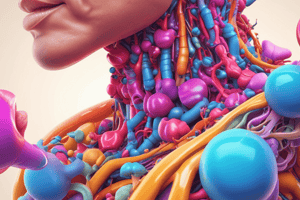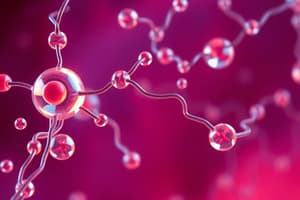Podcast
Questions and Answers
What percentage of thyroid hormone transport is attributed to Thyroxin Binding Prealbumin (TBPA)?
What percentage of thyroid hormone transport is attributed to Thyroxin Binding Prealbumin (TBPA)?
- 10%
- 20%
- 40% (correct)
- 50%
Which of the following is NOT a function of thyroid hormones?
Which of the following is NOT a function of thyroid hormones?
- Stimulate glucose uptake
- Enhance fat metabolism
- Increase basal metabolic rate
- Decrease appetite (correct)
How do thyroid hormones affect gastrointestinal motility?
How do thyroid hormones affect gastrointestinal motility?
- Increase motility and appetite (correct)
- Cause constipation
- Delay gastric emptying
- Decrease food intake
What effect do thyroid hormones have on skeletal muscle function?
What effect do thyroid hormones have on skeletal muscle function?
Which metabolic process is directly enhanced by thyroid hormones?
Which metabolic process is directly enhanced by thyroid hormones?
What is the primary function of the parafollicular C cells in the thyroid gland?
What is the primary function of the parafollicular C cells in the thyroid gland?
Which statement correctly describes the synthesis of thyroid hormones T3 and T4?
Which statement correctly describes the synthesis of thyroid hormones T3 and T4?
What percentage of thyroid hormone output does thyroxine (T4) constitute?
What percentage of thyroid hormone output does thyroxine (T4) constitute?
What is the role of iodide in thyroid hormone production?
What is the role of iodide in thyroid hormone production?
How are T3 and T4 transported in the bloodstream?
How are T3 and T4 transported in the bloodstream?
Flashcards
Thyroid Hormone Synthesis
Thyroid Hormone Synthesis
Thyroid hormones (T3 and T4) are made by actively taking iodine from the blood, oxidizing it, attaching it to tyrosine, and linking the iodinated tyrosines together.
Thyroid Hormone Storage
Thyroid Hormone Storage
Thyroid hormones are initially stored with thyroglobulin in the thyroid follicle colloid.
Thyroid Hormone Release
Thyroid Hormone Release
Upon stimulation by TSH, an enzyme breaks down thyroglobulin, releasing T3 and T4.
Thyroid Hormone Transport
Thyroid Hormone Transport
Signup and view all the flashcards
Iodine Uptake
Iodine Uptake
Signup and view all the flashcards
Thyroid Hormone Metabolic Effect
Thyroid Hormone Metabolic Effect
Signup and view all the flashcards
Thyroid Hormone Growth Effect
Thyroid Hormone Growth Effect
Signup and view all the flashcards
Thyroid Hormone & Respiratory System
Thyroid Hormone & Respiratory System
Signup and view all the flashcards
Thyroid Hormones & Carbohydrate Metabolism
Thyroid Hormones & Carbohydrate Metabolism
Signup and view all the flashcards
Thyroid Hormones & Skeletal Muscle
Thyroid Hormones & Skeletal Muscle
Signup and view all the flashcards
Study Notes
Thyroid Gland and Calcium Homeostasis
- The thyroid gland is composed of two lobes located on either side of the lower larynx and upper trachea.
- While not essential for life, the thyroid gland is crucial for growth and overall well-being.
- The functional unit of the thyroid gland is the thyroid follicle.
- Thyroid follicles are hollow spheres lined with hormone-secreting cells filled with thyroid colloid.
- Thyroid colloid contains a characteristic protein called thyroglobulin.
- Parafollicular cells are located between the follicles.
- Thyroid follicles produce thyroxine (T4) and triiodothyronine (T3).
- T4 constitutes about 90% of the thyroid output.
- T3, while released in smaller amounts, persists in the blood for a shorter time than T4, but is more active hormonally.
- Thyroid hormone synthesis involves iodide uptake, oxidation, and iodination of tyrosine.
- Iodinated tyrosines couple to form iodothyronine (T3 & T4).
- Thyroid hormones are bound to plasma proteins, primarily thyroxine-binding globulin (TBG).
- Approximately 1 mg of ingested iodine is needed weekly for normal thyroid hormone production.
- Iodized salt is often used in areas with low iodine intake to prevent deficiency.
Thyroid Hormones Functions
-
Thyroid hormones increase basal metabolic rate, oxygen consumption, heat production, and glucose uptake.
-
Heat production is driven by the acceleration of cellular catabolism.
-
Thyroid hormones stimulate physical, mental, and sexual growth, particularly in fetal life and early childhood. -Physical growth is affected by permissiveness of GH and potentiation of somatomedins.
-
Teeth eruption and development are accelerated.
-
Mental growth encompasses CNS development and nerve fiber myelination in fetal life and formative years.
-
Sexual growth and fertility are dependent on the function of the thyroid.
-
Normal thyroid function affects lactation.
-
Thyroid hormones increase rate and depth of respiration (pulmonary ventilation).
-
Thyroid hormones increase appetite and gastrointestinal tract motility.
-
Thyroid hormones increase heart rate, venous return, myocardial strength, and cardiac output.
-
Thyroid hormones increase erythropoiesis.
-
Thyroid hormones increase carbohydrate absorption, glucose uptake, and the rate of utilization.
-
Thyroid hormones contribute to carbohydrate metabolism.
-
Thyroid hormones stimulate fat metabolism, increasing free fatty acids, and accelerating oxidation of fatty acids. Fat stores also diminish as a consequence of thyroid hormone activity. Thyroid hormone lowers cholesterol levels.
-
Thyroid hormones play a role in vitamin A synthesis.
-
Thyroid hormones promote utilization and clearance of other vitamins.
-
Thyroid hormone is necessary for normal skeletal muscle function.
-
Muscle weakness can result from hyper- or hypothyroidism (related to catabolism of muscle proteins under increased production).
Control of Thyroid Function
- Plasma TRH and TSH levels control thyroid function.
- Thyroid-stimulating immunoglobulin (TSI) can stimulate thyroid activity, but is not affected by blood T3/T4 levels. TSI is the cause of Grave's disease.
- Environmental factors, such as cold exposure, stimulate thyroid activity.
- Thyroid activity naturally decreases with age.
- Pregnancy increases thyroid activity.
- Antithyroid agents (goitrogens) can hinder thyroid hormone production by interfering with iodine uptake and impairing synthesis of T3 and T4 and cause goiter.
Disorders of the Thyroid Gland
-
Hypothyroidism (hypoactive thyroid gland):
- Cretinism (infantile hypothyroidism), characterized by slowed growth and neurological development.
- Myxedema (adult hypothyroidism) characterized by weight gain, slowing of mental processes, and coldness.
-
Hyperthyroidism (hyperactive thyroid gland)
- Nervousness, tremulousness, insomnia, increased appetite with weight loss (due to accelerated metabolism) and other symptoms. Elevated basal metabolic rate, and high cardiac output (tachycardia and arrhythmias).
Calcium Homeostasis
- Daily calcium requirement is approximately 1 gram, increasing during childhood, pregnancies and lactation.
- The small intestine absorbs calcium via active transport; regulated by vitamin D.
- Normal total plasma calcium is 9-11 mg/100 ml and ionized calcium 4.5-5.5 mg/dl.
- Serum phosphorous levels are 4-5 mg/dl.
- Calcium is necessary for bone formation, enzyme activation, blood clotting, muscle contraction and neurotransmitter release.
- Blood calcium levels are controlled by parathyroid hormone (PTH), calcitonin and active Vitamin D.
Parathyroid Hormone (PTH)
- The parathyroid glands are four small oval bodies located on the back of the thyroid gland. -Normal PTH levels are 10-55pg/ml.
- PTH raises blood calcium levels by acting on bone, kidneys, and small intestines.
- PTH increases calcium and phosphorus absorption from bone; bone is used as a calcium reservoir.
- PTH increases calcium reabsorption in kidneys and diminishes the excretion of calcium.
- PTH influences vitamin D metabolism to increase the action of 1,25-dihydroxycholecalciferol leading to increased calcium and phosphate absorption from the gut.
- Hypoparathyroidism is characterized by low blood calcium levels, leading to tetany. -Manifest tetany is characterized by tonic and clonic contractions of muscles and carpal and pedal spasms. -Latent tetany has lower calcium levels, producing symptoms only with stress or specific physiological conditions such as pregnancy.
Calcitonin Hormone
- Calcitonin is a polypeptide hormone secreted by parafollicular C cells of the thyroid. -Calcitonin tends to decrease blood calcium levels.
- Calcitonin inhibits bone resorption by reducing osteoclast activity and promoting osteoblastic activity.
- Calcitonin lowers calcium reabsorption by kidneys.
- Calcitonin inhibits absorption of calcium from the intestine.
Actions of Vitamin D
- Vitamin D3 is a steroid hormone needed for calcium homeostasis.
- Vitamin D absorbs intestinal calcium, increases calcium and phosphorus absorption from the renal tubules, and promotes calcium mobilization from bone.
- Vitamin D promotes bone mineralization and development in children and adults.
Studying That Suits You
Use AI to generate personalized quizzes and flashcards to suit your learning preferences.




